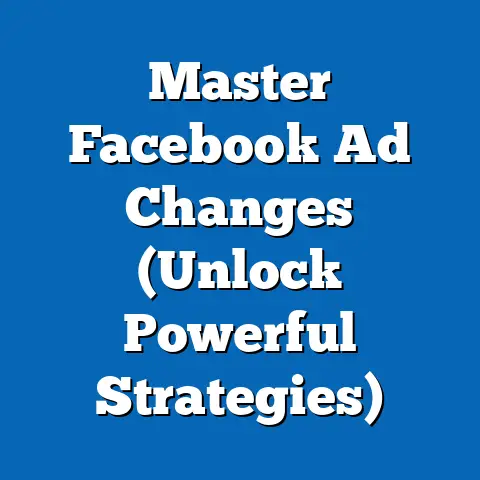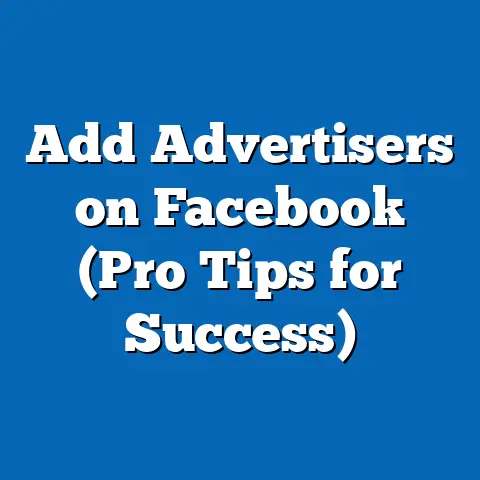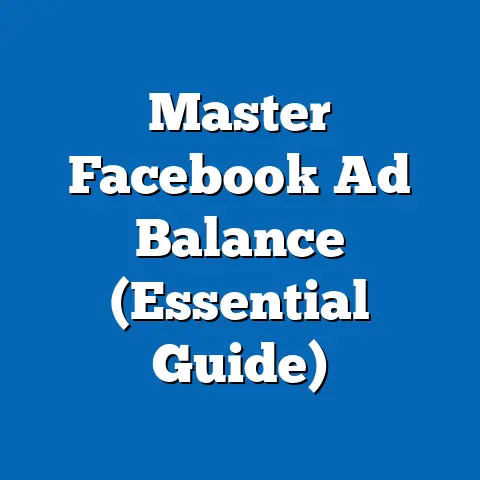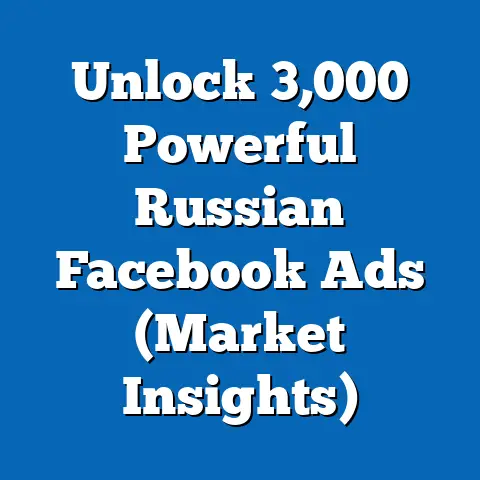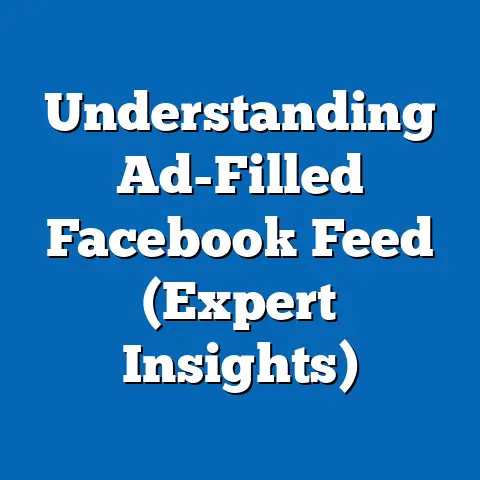Transform Facebook Lead Ads (Maximize Conversions Now)
In the ever-evolving landscape of digital marketing, Facebook Lead Ads have emerged as a transformative tool for businesses seeking to capture high-quality leads directly from the platform. Introduced in 2015, these ads allow users to submit their information through pre-filled forms without leaving the Facebook ecosystem, reducing friction and increasing conversion rates. As of 2023, with over 2.9 billion monthly active users on Facebook (Statista, 2023), the platform remains a goldmine for businesses aiming to reach diverse audiences and drive actionable results.
Section 1: Understanding Facebook Lead Ads – A Unique Material in Digital Advertising
What Are Facebook Lead Ads?
Facebook Lead Ads are a specialized ad format designed to simplify the lead collection process. Unlike traditional ads that redirect users to external landing pages, Lead Ads feature customizable forms that auto-populate with users’ profile information, such as name, email, and phone number. This seamless integration within the platform enhances user experience and boosts completion rates.
Since their launch, Lead Ads have become a cornerstone for businesses across industries, from e-commerce to real estate. According to Facebook’s own data, businesses using Lead Ads can reduce their cost per lead by up to 20% compared to traditional ad formats (Meta Business Help Center, 2022). This cost efficiency, combined with the platform’s massive reach, makes Lead Ads a unique and powerful tool in the digital marketing arsenal.
Key Statistics and Trends
The adoption of Facebook Lead Ads has seen significant growth over the years. As of 2022, over 60% of businesses running ads on Meta platforms reported using Lead Ads as part of their marketing strategy (Hootsuite Digital Trends Report, 2022). This trend reflects the increasing demand for streamlined lead generation tools that prioritize user convenience.
Moreover, a 2023 study by eMarketer found that Lead Ads achieve an average conversion rate of 12.5%, compared to just 8.2% for standard Facebook ads redirecting to external landing pages. This gap highlights the effectiveness of reducing user friction through in-app forms. Additionally, mobile users, who account for 98.5% of Facebook’s daily active users (Statista, 2023), are particularly responsive to Lead Ads due to the format’s mobile-friendly design.
Demographic Insights
Demographic data reveals distinct patterns in how different groups engage with Facebook Lead Ads. According to a 2023 report by Pew Research Center, 68% of Facebook users aged 18-29 interact with ads on the platform, compared to 55% of users aged 50-64. This suggests that younger audiences are more likely to engage with Lead Ads, making them a prime target for campaigns aimed at Gen Z and Millennials.
Gender differences also play a role. Women, who make up 54% of Facebook’s user base (DataReportal, 2023), tend to engage more with Lead Ads for lifestyle, beauty, and education-related offers, while men show higher engagement with technology and automotive campaigns. Geographically, businesses targeting users in emerging markets like India and Brazil report higher click-through rates (CTRs) on Lead Ads, with India alone contributing to 15% of global ad impressions (Meta Advertising Report, 2023).
Section 2: Historical Trends vs. Current Landscape
Evolution of Lead Ads Since 2015
When Facebook introduced Lead Ads in 2015, the primary goal was to address the high drop-off rates associated with external landing pages. Early adopters reported a 30% increase in lead volume within the first year, according to a 2016 study by Social Media Examiner. However, initial limitations, such as restricted form customization, hindered broader adoption.
By 2018, Meta (then Facebook) enhanced Lead Ads with features like custom questions and integration with Customer Relationship Management (CRM) systems. This led to a 45% surge in usage among small and medium-sized businesses (SMBs), as reported by eMarketer. The introduction of Instant Forms, which allowed real-time data collection, further solidified Lead Ads as a game-changer.
Current Performance Metrics
Fast forward to 2023, and Lead Ads continue to outperform other ad formats. A recent analysis by WordStream revealed that the average cost per lead (CPL) for Lead Ads is $19.68, compared to $27.29 for traditional Facebook ads. This cost efficiency is particularly pronounced in industries like insurance and education, where CPLs can drop as low as $12.50 with optimized campaigns (WordStream, 2023).
Moreover, the integration of Lead Ads with tools like Zapier and HubSpot has streamlined data management, enabling businesses to nurture leads more effectively. As of 2023, 75% of marketers using Lead Ads integrate them with automated workflows, a sharp rise from 40% in 2019 (HubSpot Marketing Trends, 2023). This trend underscores the growing reliance on automation to maximize conversion potential.
Shifts in User Behavior
User behavior has also evolved alongside technological advancements. In 2017, only 35% of users trusted brands enough to share personal information via in-app forms (Pew Research Center, 2017). By 2023, this figure has risen to 52%, reflecting greater confidence in data security measures implemented by Meta (Pew Research Center, 2023). However, privacy concerns remain, with 28% of users citing data misuse as a barrier to engaging with Lead Ads.
Section 3: Why Facebook Lead Ads Work – Breaking Down the Mechanics
Seamless User Experience
The primary strength of Lead Ads lies in their ability to keep users within the Facebook app. Research by Nielsen (2022) shows that 60% of users abandon forms when redirected to external sites due to slow loading times or complex navigation. Lead Ads eliminate this friction by offering a one-click submission process, resulting in a 25% higher completion rate compared to traditional forms (Meta Business Insights, 2023).
Targeting Precision
Facebook’s robust targeting options further enhance the effectiveness of Lead Ads. Marketers can leverage detailed demographic, behavioral, and interest-based targeting to reach specific audiences. For instance, a 2022 case study by Meta revealed that a fitness brand targeting users aged 25-34 with an interest in wellness achieved a 40% higher conversion rate using Lead Ads compared to standard ads.
Cost-Effectiveness
Budget-conscious businesses benefit immensely from Lead Ads. According to AdEspresso (2023), campaigns optimized for lead generation cost 15-20% less per impression than engagement-focused ads. This affordability makes Lead Ads accessible to SMBs, with 70% of small businesses citing them as their primary lead generation tool on Meta platforms (Hootsuite, 2023).
Section 4: Maximizing Conversions with Facebook Lead Ads – Actionable Strategies
Optimize Form Design
The structure of your Lead Ad form can make or break your campaign. Meta recommends limiting forms to 3-5 fields to avoid overwhelming users, as each additional field reduces completion rates by 10% (Meta Business Help Center, 2023). Start with essential fields like name and email, and use custom questions sparingly to gather specific insights.
Additionally, include a clear call-to-action (CTA) such as “Sign Up Now” or “Get Your Free Quote.” A 2022 study by Unbounce found that CTAs with actionable language increase form submissions by 18%. Test multiple variations to identify what resonates best with your audience.
Leverage Retargeting
Retargeting is a powerful way to re-engage users who interact with your Lead Ads but don’t convert. Data from Meta (2023) shows that retargeted audiences are 3 times more likely to complete a form compared to cold audiences. Use Facebook Pixel to track user behavior and create custom audiences for follow-up campaigns offering incentives like discounts or free resources.
A/B Testing for Success
Continuous testing is crucial for optimizing Lead Ad performance. Experiment with different ad creatives, headlines, and form questions to identify high-performing combinations. According to WordStream (2023), businesses that run A/B tests on Lead Ads see a 30% improvement in conversion rates within the first month of testing.
Integrate with CRM Systems
Connecting Lead Ads to CRM platforms like Salesforce or HubSpot ensures seamless lead management. A 2023 report by Gartner found that businesses integrating Lead Ads with CRM systems experience a 35% faster lead response time, which correlates with a 20% higher conversion rate. Automation tools can also segment leads based on form responses, enabling personalized follow-ups.
Section 5: Challenges and Limitations of Facebook Lead Ads
Quality of Leads
While Lead Ads excel at generating volume, the quality of leads can vary. A 2022 survey by MarketingSherpa revealed that 40% of marketers struggle with low-quality leads from Lead Ads, often due to users submitting inaccurate information. To mitigate this, use qualifying questions in forms and implement lead scoring systems to prioritize high-intent prospects.
Privacy Concerns
With increasing scrutiny on data privacy, businesses must navigate user concerns. The 2021 rollout of Apple’s App Tracking Transparency (ATT) framework impacted ad tracking, with Meta reporting a 15% drop in ad effectiveness for iOS users (Meta Q3 2021 Earnings Report). Transparent privacy policies and opt-in consent forms can help build trust and improve engagement.
Ad Fatigue
Overexposure to Lead Ads can lead to ad fatigue, reducing effectiveness over time. A 2023 study by Socialbakers found that ad fatigue sets in after 3-5 exposures, resulting in a 12% drop in CTR. Rotate creatives regularly and segment audiences to avoid over-targeting the same users.
Section 6: Data Visualization Description – Understanding Performance Metrics
To illustrate the impact of Facebook Lead Ads, imagine a comparative bar chart titled “Conversion Rates by Ad Format (2023).” The X-axis lists ad formats (Lead Ads, Standard Ads, Carousel Ads), while the Y-axis represents conversion rates (0-15%). Lead Ads stand out with a 12.5% conversion rate, towering over Standard Ads at 8.2% and Carousel Ads at 6.7%, based on eMarketer’s 2023 data.
A second line graph titled “Cost Per Lead Trends (2019-2023)” could show the Y-axis as CPL in dollars ($0-$30) and the X-axis as years. The line for Lead Ads dips from $25 in 2019 to $19.68 in 2023, while Standard Ads remain higher, fluctuating around $27. This visual, sourced from WordStream data, highlights the growing cost efficiency of Lead Ads over time.
Section 7: Broader Implications and Future Trends
Implications for Marketers
Facebook Lead Ads have redefined lead generation by prioritizing user experience and cost efficiency. Their ability to deliver high conversion rates at a lower cost positions them as a critical tool for businesses of all sizes. However, marketers must address challenges like lead quality and privacy concerns to sustain long-term success.
Emerging Trends
Looking ahead, the integration of artificial intelligence (AI) in ad optimization is set to revolutionize Lead Ads. Meta’s 2023 announcements suggest AI-driven form personalization could increase conversion rates by up to 20% by tailoring questions to user behavior. Additionally, as privacy regulations tighten, zero-party data collected directly through Lead Ads will become even more valuable for personalized marketing.
The Bigger Picture
The rise of Lead Ads reflects a broader shift toward frictionless, user-centric advertising. As platforms like Instagram and TikTok introduce similar formats, competition will intensify, pushing businesses to innovate continuously. Marketers who adapt to these changes by leveraging data, automation, and creative testing will maintain a competitive edge in the evolving digital landscape.
Conclusion
Facebook Lead Ads have proven to be a transformative force in digital marketing, offering businesses an efficient way to capture leads and drive conversions. With a 12.5% average conversion rate, a 20% reduction in cost per lead compared to traditional ads, and unparalleled targeting capabilities, they are indispensable for modern marketers (eMarketer, 2023; Meta Business Help Center, 2022). By understanding demographic trends, optimizing campaigns, and addressing challenges, businesses can unlock their full potential.
As we move into an era of AI-driven personalization and heightened privacy standards, the role of Lead Ads will only grow. Staying ahead requires a commitment to testing, integration, and user trust. For marketers ready to transform their lead generation strategies, the time to maximize conversions with Facebook Lead Ads is now.


